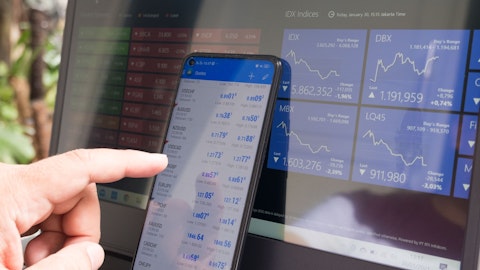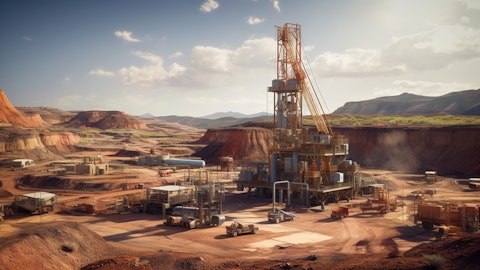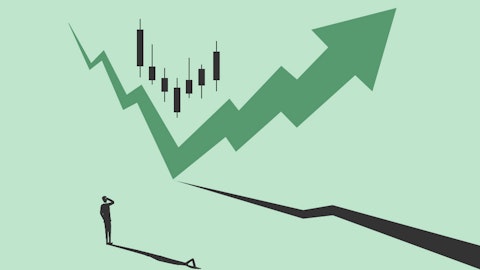Albemarle Corporation (NYSE:ALB) Q4 2023 Earnings Call Transcript February 15, 2024
Albemarle Corporation isn’t one of the 30 most popular stocks among hedge funds at the end of the third quarter (see the details here).
Operator: Hello and welcome to Albemarle Corporation’s Fourth Quarter 2023 Earnings Call. All lines have been placed on mute to prevent any background noise. After the speaker’s remarks, there will be a question-and-answer session. [Operator Instructions] I will now hand it over to Meredith Bandy, Vice President of Investor Relations and Sustainability.
Meredith Bandy: Thank you. And welcome everyone to Albemarle’s fourth quarter and full year 2023 earnings conference call. Our earnings were released after the close of market yesterday and you’ll find the press release and earnings presentation posted to our website under the Investor Section at albemarle.com. Joining me on the call today are Kent Masters, Chief Executive Officer; and Neal Sheorey, Chief Financial Officer. Netha Johnson, President of Specialties; and Eric Norris, President of Energy Storage are also available for Q&A. As a reminder, some of the statements made during this call, including our outlook considerations, guidance, expected company performance and timing of expansion projects, may constitute forward-looking statements.
Please note the cautionary language about forward-looking statements contained in our press release and earnings presentation that also applies to this call. Please also note that some of our comments today refer to non-GAAP financial measures. Reconciliations can be found in our earnings materials. And now, I’ll turn the call over to Kent.
Kent Masters: Thank you, Meredith. Now, starting on slide four, our full year results show continued strong volumetric growth, with 2023 marking the highest net sales and second highest EPS in Albemarle’s history. This highlights the focus and ability of our global team to succeed in a macro environment that remains challenging. We ended the year with net sales of $9.6 billion, up 31% compared to 2022, of which 21% was related to volume growth. Energy Storage delivered 35% volumetric growth in 2023. For the full year of 2023, Albemarle’s adjusted EBITDA was $2.8 billion or $3.4 billion excluding a lower cost or market charge recorded in the fourth quarter. Excluding this non-cash charge, adjusted EBITDA was in line with our previous expectations.
In January, we announced a series of proactive measures to re-phase our organic growth investments and optimize our cost structure. These disciplined actions should allow us to unlock more than $750 million of incremental cash, advance near-term growth and preserve future opportunities. Today, we will provide our initial thoughts on our full year 2024 earnings. To help investors model Albemarle in the current environment, we will introduce scenarios based on recently observed lithium market prices. Neal will provide more details on this in a few minutes. We remain as confident as ever in the future of Albemarle and ongoing demand for the essential elements we provide to support modern infrastructure, including mobility, energy, connectivity and health.
The secular trends of clean energy, electrification and digitalization continue to drive growth. We are uniquely positioned to capitalize on the opportunities in our end markets, in particular lithium demand. Over the past year, we have further strengthened Albemarle’s position and are committed to navigating the near-term dynamics in a disciplined manner to both support and capitalize on these global trends. I’ll now hand it over to Neal to discuss our financial results.
Neal Sheorey: Thanks, Kent, and good morning, everyone. It’s a pleasure to join my first earnings call with Albemarle. I’ve hit the ground running, and in the coming weeks, I’ll be on the road meeting with our shareholders and analysts. I’m looking forward to reconnecting with many of you and building new relationships with those of you I haven’t yet met. Moving to slide five, I’ll start with a review of our fourth quarter and full year 2023 performance. In Q4, we reported net sales of $2.4 billion, down 10% compared to last year, as lower lithium market pricing was partially offset by increased volumes in Energy Storage and higher volumes in pricing in Ketjen. As Kent mentioned, we recorded two charges in Q4 that impacted results.
The first was a lower of cost or market charge of $604 million and the second was a tax valuation allowance in China of $223 million. These charges were fundamentally related to the fact that in the second half of 2023, lithium market prices feel over a relatively short period of time. In the case of the LCM charge, market prices reached a level such that our cost of inventory, especially spodumene, which we purchased at a market price from our Talison JV, was above the market price of the final lithium salts, which resulted in us writing down the value of our inventory in accordance with GAAP. Similarly, in the case of the tax valuation allowance, the rapid decline in market prices led us to recognizing losses in China as we process the higher cost spodumene in inventory.
In China, we are only allowed a five-year carry-forward period to utilize these losses. In accordance with GAAP, we recognize the valuation allowance against the losses. The company’s full year results excluding those charges met our previously announced expectations. Net sales of $9.6 billion were up 31%, primarily driven by volume growth. Adjusted diluted EPS, excluding both charges, was $22.25, roughly flat year-over-year. Looking at slide six, fourth quarter adjusted EBITDA was $289 million, excluding the lower of cost or market charge. This primarily reflects a decrease in Energy Storage adjusted EBITDA, driven by a lower lithium market pricing, which more than offset higher volumes. In Specialties, adjusted EBITDA declined $64 million, primarily due to lower sales volumes and pricing, reflecting ongoing demand weakness in key end markets.
Ketjen adjusted EBITDA increased $34 million, as higher sales and higher pricing more than offset increased raw materials costs. Turning to slide seven, before I transition to forward-looking information, I want to take a moment to review our adjusted EBITDA definition and share an update that we plan to make. Effective with Q1 2024, we are updating our definition of adjusted EBITDA to include Albemarle’s share of the pre-tax earnings of our Talison joint venture. There are a few important reasons for this change. First, the updated definition better reflects our vertical integration with Talison’s Greenbushes mine, one of the world’s largest, highest grade and lowest cost lithium resources. Second, it smooths the impact of price variations in inventory timing that obscure the underlying profitability of our full-chain integration.
And finally, this definition is consistent with the amendment to our revolving credit facility, which I’ll discuss later on the call. As a reference point, on this slide, we’ve given you both the Energy Storage and Albemarle full year 2023 adjusted EBITDA under the previous and updated adjusted EBITDA definition. We will report under the updated definition in 2024. Therefore, all of our comments and numbers regarding 2024 modeling considerations are based on this new definition. Turning to slide eight, to help investors model Albemarle’s earnings under different price scenarios, we have provided ranges of outcomes for our Energy Storage business based on three lithium market price scenarios that were observed in the back half of 2024.
First, year-end 2023 market pricing of about $15 per kilogram of lithium carbonate equivalent or LCE. Second, Q4 2023 average market pricing, which was about $20 per kilogram of LCE. And third, second half 2023 average market pricing, which was about $25 per kilogram of LCE. Within each scenario, the ranges are based on our expectation to increase Energy Storage volumes by 10% to 20% in 2024 compared to 2023. All three scenarios assume flat market pricing flowing through Energy Storage’s current book of business. These scenarios demonstrate the resilience of our Energy Storage business. As you would expect, given our strong resource positions around the world, we can maintain solid margins even with lower year-over-year lithium pricing, which are further bolstered by our organic volumetric growth and the normalization of temporary inventory timing impacts.
Moving to slide nine, here we provided modeling considerations for Specialties, Ketjen and Corporate. We expect Specialties 2024 net sales of $1.3 billion to $1.5 billion and adjusted EBITDA of $270 million to $330 million. Ketjen 2024 net sales are expected to be $1 billion to $1.2 billion with adjusted EBITDA of $130 million to $150 million. The Corporate outlook reflects our planned decrease in capital expenditures, which we expect to total $1.6 million to $1.8 billion in 2024, down from $2.1 billion in 2023. Corporate costs in 2024 are expected to be between $120 million and $150 million. Corporate costs in 2023 included interest income that is not expected to recur, and therefore, excluding this factor, Corporate costs are relatively flat year-over-year.
Adding it all together on slide 10, we provided here the full roll-up of Albemarle under each of the Energy Storage price scenarios. Turning to slide 11, I’ll provide some further detail on the trends that underpin each segment’s outlook. In Energy Storage, approximately two-thirds of 2024 estimated volumes are expected to be sold on index-referenced, variable-priced contracts. The remaining approximately one-third of volume is expected to be sold on short-term purchase agreements. This is a modest change from our past mix and reflects our positioning in this lower price environment. We could potentially add additional long-term contracts, but we will only entertain that if the pricing and other terms reflect long-term industry fundamentals.

Energy Storage volume is expected to be weighted toward the second half of 2024 as our own capacity expansions ramp and as we experience normal seasonality. Specialties results are also expected to be back-half-weighted. The Specialties outlook reflects continued softness and opaque demand conditions in consumer electronics and elastomers and markets, partially offset by strong demand in oilfield services, agriculture and pharmaceuticals. We continue to actively monitor the situation in the Middle East, and in particular the Red Sea, and are working with our partners to facilitate safe, efficient and cost-effective transport of our products to customers. To-date, operations continue largely as normal, though we are experiencing some shipping delays and tighter availability of processing materials.
In Ketjen, we are optimistic about increased volumes driven by high refinery utilization, as well as higher pricing, primarily in clean-fuel technology products. Ketjen made good progress against its improvement plans in 2023 and we are expecting another year of improvement in both net sales and adjusted EBITDA. Moving to slide 12, we continue to deliver volumetric growth with line-of-sight to a growth CAGR of about 20% from 2022 to 2027. Our expected 2024 volume growth reflects projects that are at or near completion and which we have prioritized as we reduce capital spending in other areas. This includes commissioning and startup of the Meishan lithium conversion facility, completion of commissioning activities at the Kemerton lithium conversion facility and ongoing expansions at Silver Peak, La Negra and Qinzhou.
Our long-term expected lithium sales volumes are mostly unchanged as we continue to utilize flexible tolling arrangements to bridge to full capacity at our conversion expansions, as well as pace supply to current market conditions. Turning to slide 13, this is an update to a slide we provided last quarter, which explains how Energy Storage margins are impacted by JV accounting and the inherent timing lag that occurs from the mine through our conversion processes. The inventory lag we saw beginning in the second half of 2023 is expected to be reduced for two reasons. First, the lower of cost or market charge recorded in Q4 2023 resets inventory costs closer to current market pricing. And second, the Talison JV partners recently agreed to change the spodumene pricing to M-1 or a one-month lag versus the prior use of a three-month lag.
That said, these changes will not completely offset the inventory lag, particularly in a period where prices have significantly changed. And therefore, we expect our first half 2024 margins in Energy Storage to be impacted by the lag as we process higher cost spodumene inventory and by expected reduced sales from Talison to our JV partner. Importantly, when we look beyond these temporal impacts, we estimate that Energy Storage could exit the year at a margin of approximately 30%, assuming constant current market pricing and a return to normal shipments from the Talison JV. Turning to slide 14 and our financial position. As our rapid action in recent months has shown, we are committed to maintaining a solid investment-grade credit rating and enhancing our financial flexibility as we navigate the lower price environment.
With our earnings release yesterday, we announced that we have completed an amendment to our revolving credit facility to ensure ongoing financial flexibility. The amendment uses the revised adjusted EBITDA definition consistent with the definition that we will use for financial reporting going forward. I’m happy to share that we had unanimous support from our bank syndicate for the amendment. This action, along with all the steps we are proactively taking as a company to modify our cost and capital spending, demonstrates our focus on maintaining financial flexibility, adapting with changing market conditions and exercising our investing discipline. With that, I’ll turn it back over to Kent to provide more details on our actions to preserve growth, reduce costs and optimize cash flow.
Kent Masters: Thanks, Neal. And now turning to slide 15. In markets as dynamic as ours, growth companies must be able to pivot and pace with disciplined decision-making and focused execution. This is especially true for Albemarle as a trusted leader in the markets we serve. At Albemarle, disciplined growth means carefully prioritizing CapEx timelines when pricing moves higher and re-phasing when the market shifts. As we look to 2024 and the current market dynamics, we’ve identified certain strategic investments and projects across the enterprise that do not need to grow as fast in the short-term. In short, the returns for new projects are not there at these prices, which we believe are well below reinvestment levels. As a result, we are reducing our CapEx in 2024 by $300 million to $500 million versus 2023 by refocusing our energy on the large, high return projects that are significantly progressed near completion or in startup.
Additionally, we are aligning our OpEx to a slower pace of investment. We are taking action to reduce costs by nearly $100 million and we expect to realize more than $50 million of these savings in 2024. Our actions include reducing headcount and lowering spending on contracted services. We also continue to evaluate and execute the sale of non-core investments. For example, we recently monetized our Liontown holdings, given our decision to withdraw our non-binding offer. At the same time, we’re pursuing additional cash management actions, including optimizing our working capital. This includes initiatives focused on shortening the time from the mine to the customer in our supply chain. These measures together are expected to unlock more than $750 million of cash flow in the near term.
This disciplined approach to managing the current market downturn reflects the actions that we must take to preserve our financial flexibility and re-pace our investments. The actions we are taking today will position Albemarle to emerge stronger to the benefit of our shareholders, partners, employees and the communities in which we operate. Moving to slide 16, the specific re-phasing decisions within our 2024 CapEx plan include continuing critical health, safety, environmental and site maintenance projects, commissioning the Meishan lithium conversion facility, which reached mechanical completion at the end of 2023, completing commissioning activities for trains 1 and 2 at the Kemerton lithium conversion facility and prioritizing construction on train 3 of the Kemerton Expansion Project, and prioritizing permitting activities at the Kings Mountain spodumene resource.
We continue to have significant optionality for long-term organic growth. At the same time, if pricing remains below reinvestment economics, we will be disciplined and hold capital at or below current levels for the foreseeable future. Moving to slide 17, the Albemarle way of excellence remains the standard by which we operate and continues to serve us well in 2024. Here we provide more details on operational discipline, a key pillar of our operating model, especially given the current environment. In 2023, we realized productivity benefits of more than $300 million, well ahead of the initial target of $170 million and we’ve identified plans that target another $280 million in productivity benefits this year. In manufacturing, we continue to implement initiatives on overall equipment effectiveness, including improvements to recovery and utilization with expected benefits of $80 million.
In procurement, we are targeting benefits of $150 million by pooling Corporate spend and continuing our strategic sourcing to recognize lower raw material pricing. And finally, after restructuring certain back office functions and with reprioritized projects, we expect to realize $50 million of productivity improvements. Slide 18 demonstrates the adjustments we’ve made to our capital allocation priorities as we navigate the dynamics of our key end markets. Our four capital allocation areas remain the same with shifts in how we prioritize. As Neal highlighted earlier, maintaining our financial flexibility in this environment is a central area of focus. We’ll continue to selectively invest in high return growth, but we’ll be patient and disciplined.
We expect minimal M&A in this environment as we primarily focus on organically accelerating growth at attractive returns. As we have mentioned before, we’ll continue to actively assess our own portfolio to identify opportunities to create value. Moving to slide 19, while the pricing environment has softened for the moment, we should not lose sight of the fact that we continue to see significant long-term growth in demand for limited supply. This updated forecast is about 10% below our previous forecasts from early last year and it now reflects recent OEM announcements, more moderate battery size growth and inventory destocking. At the same time, global EV penetration is expected to grow significantly, resulting in anticipated 2.5 times lithium demand growth from 2024 to 2030.
In 2024 alone, we expect demand growth of 28%. To put it another way, we expect that this industry needs more than 300,000 metric tons of new LCE capacity every year. In our view, incentivizing producers to meet this demand requires long-term pricing at or above investment economics and certainly above current market pricing. At today’s prices, the economics for new greenfield projects, particularly in the west are not supported. We expect near-term supply to be relatively balanced with demand and you see that adjustment starting to happen with recently announced production curtailments and project delays, including our own. As a leader, Albemarle remains well positioned to capitalize on the long-term growth trends we see in front of us, but we’ll be disciplined in how we capture our share of it.
Slide 20 shows our durable competitive advantages and how Albemarle can win as we navigate near-term conditions. We are vertically integrated with a globally diversified portfolio of world-class, low-cost resources and industrial scale conversion assets. Albemarle has leading process chemistry that allows us to build and operate large-scale assets safely and efficiently. As a leader in the markets we serve, we are a partner of choice to strategic customers and stakeholders that seek to drive innovation and growth. For example, we recently signed a multiyear supply agreement with BMW, which takes effect in 2025. That agreement will also allow both companies the opportunity to partner on technology for safer and more energy-dense lithium-ion batteries.
And last but certainly not least, we are committed to operating sustainably with industry-leading ESG performance and partnering with customers and suppliers to benefit the entire supply chain. As Albemarle adapts to the market dynamics, both present and future, we are confident in our ability to deliver on our strategy and drive value for shareholders. With that, we’d like to turn the call back over to the Operator to begin Q&A.
Operator: [Operator Instructions] Your first question comes from a line of Stephen Richardson from Evercore ISI. Your line is open.
See also 20 Most Dangerous Countries that American Tourists Usually Visit and 20 Fastest Growing E-Commerce Companies in 2024.
Q&A Session
Follow Albemarle Corp (NYSE:ALB)
Follow Albemarle Corp (NYSE:ALB)
Stephen Richardson: Hi. Good morning. I just wanted to get a clarification on slide 12, which is always very helpful in terms of sales volumes. Could you comment on what were your fourth quarter sales volumes and what do you expect Q1 to be?
Kent Masters: Neal, you want to take that?
Neal Sheorey: Sure. Hi, there. Good morning, Stephen. So if I heard your question right, you were looking for volume growth that we had in the fourth quarter, as well as volume growth that we expect in the first quarter. So we haven’t — with regards to 2024, we haven’t given the specific volume growth numbers across the specific quarters in 2024. As we mentioned, we expect 10% to 20% growth in the year in 2024 and really the growth trajectory in the year will be dependent on how quickly we can ramp our existing assets that are in startup at the moment.
Stephen Richardson: Thanks. Maybe just a follow-up specifically on assets. The 10-K, which it looks like you just filed, suggests, just looking at those numbers, that the Atacama was flat year-over-year. Is — could you just give us an update on the Salar expansion and what the status is in Chile right now in terms of incremental volumes?
Kent Masters: Yeah. So I can start. Eric can fill in a little bit. So at the Salar, we were operating at capacity. We’ve done expansions at La Negra. We need brine to feed that. So that expansion is complete. But we need the brine from the Salar to feed that and then we — we’re in commissioning of the Salar Yield Project. That’s the project that will provide the additional brine. But once we do that, it has to work its way through the brine system, and then we can, that’ll end up feeding the La Negra project. And I think that’s probably, Eric, a six-month lag, roughly, from a Salar perspective?
Eric Norris: Yeah. I mean, for virgin brine that we pump, it’s — I think the rule of thumb has been more like 18 months, but for the Salar Yield, it’s six months. We commissioned that in the middle of last year. That’s enabling, Steve, the growth that we will see in that 10% to 20% range. A big chunk of that is coming out from carbonate, from Chile, from the La Negra plant, enabled by Salar Yield.
Stephen Richardson: Perfect. Thanks very much.
Operator: Your next question comes from a line of Colin Rusch from Oppenheimer. Your line is open.
Colin Rusch: Thanks so much, guys. Can you talk a little bit about what you’re looking for as triggers for either Salar and — or re-accelerating some of the CapEx investments for the rest of the year?
Kent Masters: Yeah. So, I mean, to be blunt, I think that’s going to be about the pricing levels that we see and the trends that we see. So, we see demand there. The volume growth in the industry is there and we start seeing some projects come out, operating projects, as well as projects on the books, like the ones that we described. So, for us to kind of re-accelerate, if you will, we’ll need to get a better view of what pricing is and the long-term view of that as well. So we think what the prices today are unsustainable. They’re below operating cash levels of some assets that are currently operating and they’re definitely below reinvestment levels, and as we said, particularly in the West, there’s not a particular price that kicks up necessarily a range of projects off.
It’s all individual, depending on the resource, where it’s located, what the cost position is of that and the conversion asset, where that’s located. So, there’s not one number that we will look at, but we’ll look at it project-by-project, but it’s not going to — if spot prices hit a number, that’s not going to necessarily turn us back into investment mode. We need to have a view that that’s a long-term number that we can rely on through the life of that asset.
Colin Rusch: Thanks so much. You’ve talked about inventory levels for the industry in the past and I wanted to get an updated view on what you think is a normalized inventory level for the channel to keep things healthy and moving and what you’re seeing right now in terms of inventories on hand through the channel?
Eric Norris: Hey, Colin. Hi. It’s Eric. We’ve spent a lot of time looking at inventory and there’s been a drawdown effect that’s been on and off throughout all of last year and into this year. At the top of the supply chain upstream, looking at lithium salts and even the next level cathode production, we feel that inventory is normalized. The drawdown we’re seeing now, harder to predict and understand because it’s less visible to us, is at the battery cell, battery module and EV level. There are a lot of reports out there that vary on that. It’s not a highly quantitative or a highly known number, but I — we think there’s probably a couple months’ excess as we exited last year, that will be drawn down this year that’s going to affect apparent demand.
So that’s why our demand forecast is a difference if you look at, I can’t remember which slide it is, the lithium supply side towards the back of the deck between lithium demand growth and EV growth, and that is that drawdown effect happening at the battery and EV level.
Colin Rusch: That’s super helpful. Thanks so much, guys.
Operator: Your next question comes from the line of Steve Byrne from Bank of America. Your line is open.
Steve Byrne: Yeah. Maybe just continuing on that discussion, where is it that you see the glut of inventory that is driving spot prices down? Is it spodumene inventories at converters that is really where the glut of material is?
Neal Sheorey: Hey, Steve. I’ll repeat what I said before. It is not upstream. We’re not seeing large inventory levels. We’re actually seeing projects, spodumene projects, go into care and maintenance. There’s several in Canada, or excuse me, in Australia, there’s one in Canada and some others that are questionable that we’re watching closely. And so it’s not there, it’s not at the conversion level. We track that as well, as well as the direct consumer for us, which is the cathode companies. We have very high visibility to that. That was at one point fairly high a year ago. That has since come down. The inventory that we’re seeing is further downstream, as I was saying earlier. It’s the battery and EV level of supply chain and that is affecting apparent demand to the lithium industry, albeit EVs are growing quite healthfully about 30% we see for the year going forward.
Steve Byrne: What would you say is driving the spot price of hydroxide to be meaningfully lower than carbonate in China and does it make sense for you to cut your operating rates to tighten that market up and drive an inflection?
Neal Sheorey: Well, look, I’ll answer the price question. Maybe Kent would like to comment on the broader supply question. On the price question, I think what you’re seeing in China is particular, let’s remember China’s almost three quarters, two-thirds to three quarters of lithium supply is consumed in China. It’s very much the market where things are set and the trend there has been strongly towards, in the past year, towards carbonate for LFP production. That trend is the opposite in other parts of the world that are developing like Europe and North America, although we are seeing LFP interest. So those two products are starting to balance out, looking to be closer to 50-50 in their mix, although we have to watch it.
It will move with time as technology and scale economies develop. That is causing that near-term, if you will, putting things upside down because historically hydroxide has been higher than carbonate. In the near-term, we’re seeing that flip. We would expect that to revert over time as the industry grows. Do you want to comment on supply more broadly, Kent?
Kent Masters: I don’t — I mean I don’t know if I have anything much to add to that. I think we supply hydroxide and carbonate. We tend to supply carbonate from Chile. So we are — that capacity is growing, as we just talked about a little bit earlier. We will supply that into the LFP market. And then we are trying to be balanced between hydroxide and carbonate and catch those growing trends. It is a little bit more skewed toward carbonate at the moment and –but we think hydroxide catches up to that. Then your question about should we lower rates to bring that back into balance. So I don’t — we are still ramping up and we still see growth in the market of 20% a year. We are 10% to 20% for us this year and the market is a little bit stronger than that. I think that demand catches up without us having to adjust operating rates. We are still trying to commission plants and catch up to that.
Steve Byrne: Thank you.
Operator: Your next question comes from a line of Josh Spector from UBS. Your line is open.
Josh Spector: Good morning. Good morning. So I had a couple of questions around your pricing scenarios. When you talk about $15 a kilogram on the Asian markets, what is implied in that scenario in terms of Albemarle realized pricing and really getting towards the impact of floors, if that is meaningful or not or if anything has changed in that regard?
Neal Sheorey: Yes. Josh, it is a bit of a complicated picture, because as you may know, there are varied price indices out there. There are some for China and some for outside China. Those inside tend to be 10% to 15% lower just because of the structural differences and some other aspects that drive that. But in any event, as you look at an average price across the two, we are going to be higher than the index generally for a couple of reasons, as — particularly as prices go low. One is floors, so it’s — our price is a little more sticky, even though it is linked to the index. And then the other is our mix. We tend to be more biased to outside China than in. That being said, where the price goes, that will be the trend that our ASP, our average selling price, follows.
Josh Spector: Your EBITDA ranges for 15% versus 20% versus 25%. It is the same change in EBITDA between each range. If there were floors in the high-teens, low 20s, wouldn’t the increment from 15% to 20% be a bigger step up than 20% to 25%? I guess, what would I be missing in that math?
Kent Masters: Josh, we might need to look at the math you are doing, because actually the transitions between those different scenarios are a little bit different and actually if you do some averaging math in those scenarios, you will see how we have a little bit different jump between the three different scenarios.
Josh Spector: Okay. I will follow up on that offline. Thanks.
Operator: Your next question comes from a line of Jeffrey Zekauskas from JPMorgan. Your line is open.





